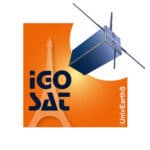
IGOSat is a 3U CubeSat, mainly developed by students, that will carry two payloads: a GPS receiver to perform radio occultation measurements in order to study the ionosphere, and a high energy scintillator to study the radiative content (electrons and gamma-rays) of the radiation belt.
The project started in 2013, within the LabEx UnivEarthS which brings together scientists from several French research laboratories, It has financial and technical support from the French space agency CNES (Centre  National d’Etudes Spatiales) and the Space Campus of the Université de Paris.
National d’Etudes Spatiales) and the Space Campus of the Université de Paris.
Mixes off-the-shelf components with custom-built
In the laboratory, we design the hardware for some platform systems (power, attitude control, interface boards), as well as the scintillator payload. We then integrate those systems with off-the-shelf components such as the telecommunication system, the GPS receiver, and the On Board Computer (OBC). We also develop software, notably for the systems holding microcontrollers, but especially for the OBC, which is running FreeRTOS on an Atmel AT91SAM9G20.
The role of the OBC is to oversee the execution of all functions aboard the satellite. A significant amount of tasks will be carried out in a cooperative scheduling environment, and this is where Tracealyzer comes into play. Ensuring the functionality of the command control or the management of our payloads requires a precise knowledge of how each process interacts with the one another. The academic license provided by Percepio allows us to develop and advance our design in this manner.
Re-evaluate initial design decisions
As we are reaching the final stages of IGOSat development, we will use Tracealyzer to re-evaluate our initial design decisions regarding task priorities and periodicity, and to establish a proper graph of our running process depending on the satellite mission mode. We also plan to use Tracealyzer as a debugging tool, which may be relevant to stack consumption, task creating/deleting process, and so on.
Learning how to use Tracealyzer was fairly easy thanks to the documentation and tutorials provided on the Percepio website.
Alexandre Malecot, IGOSat Software Engineer, Université de Paris
If you are studying or teaching embedded development, you too may be able to use Tracealyzer for free. You are welcome to check out our Academic Licenses.
